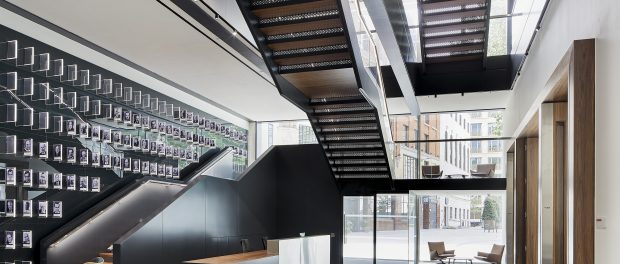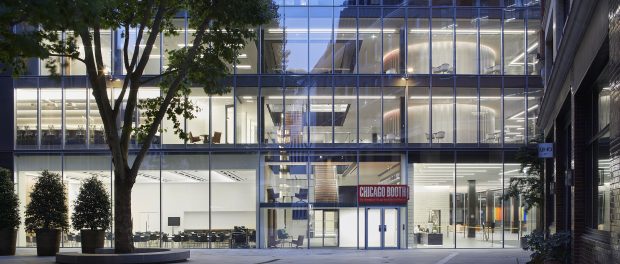Building better education: Where school architecture can go from here
 Richard Hyams
Richard Hyams
Schools across the UK have faced an extremely challenging year, from teething problems associated with remote learning to the logistical nightmare of preparing for the return of pupils post-lockdown. As governing bodies look ahead to 2021, it will be vital to consider how schools can improve their buildings to provide maximum resilience against the challenges of the future.
It was extremely encouraging to see £560m of investment being fast-tracked to support improvements to schools’ buildings earlier this year. However, with resources currently stretched, schools need to think hard about how best to use the funding made available to them. By embracing technological developments this has the potential to provide the best returns on investments from a financial, environmental, and educational perspective.
Pandemic-proof technology
The struggles schools have faced in welcoming pupils back onsite since the end of the first lockdown have been well-documented. With more long term solutions required ; Authorities could turn their attention to technology to help ensure the safety of staff and students both during and beyond the pandemic. ‘Smart schools’ may sound like something from science fiction, but many of us already live in smart homes and work in smart offices, and the power for schools to follow suit is very real.
Technological infrastructure can work in the interests of public health by mitigating the risk of COVID-19 transmission within schools. Footfall pathways and motion sensors, for example, can monitor the occupancy and density of learning spaces, and flag potential overcrowding concerns in real time. In addition to being obvious assets in the COVID-19 era, these facilities can also help ensure the most efficient use of school spaces. Moreover, environmental monitors have health benefits beyond COVID-19, with air quality controls able to counteract potentially high levels of CO2 in classrooms and corridors.
While safety should undoubtedly be schools’ highest priority, efficient means of learning has taken a significant hit in recent months. Technology can bring benefits here too, such as connectivity solutions which meet the needs of remote learners. With many students having to balance in-person learning with virtual attendance, a greater number of classrooms need to adopt adequate videoconferencing facilities to ensure that those left at home are not left behind. A school is its people, not its buildings, and the right tech can help keep those classes and cohorts together.
Sustainable schooling
The technological infrastructure of a school can also be geared towards reducing the institution’s carbon footprint, which must take on increasing importance as the global environmental situation deteriorates. Schools can play their part, with footfall pathways designed to monitor occupancy doubling up as energy efficiency trackers. By alerting facilities managers to empty rooms where heating and lighting are being wasted, these systems can inform energy savings which will in turn save costs and reduce environmental impact.
Sustainability can also be incorporated into the building fabric of schools. For example, with skins of algae compounds known as ‘living walls’, which remove CO2 from the air and can later be harvested as a form of biofuel. By producing their own energy as well as reducing wastage, schools can reinforce their ties to the local community by allowing the latter to share in the benefits reaped from their sustainably produced fuel.
Schools built using modern methods of construction such as modular, can reduce their carbon footprint even further. The construction sector is the UK’s largest consumer of natural resources, devouring more than 400m tonnes of material each year.[1] Modular construction, however, produces up to 90% less waste than traditional processes, largely by recycling waste materials into other projects, or using more eco-friendly materials in the first place.[2] Modular school buildings can therefore build in sustainability from their very foundations.
A modular solution
Modular school buildings can be as cost-effective as they are environmentally friendly. Their construction in a factory setting allows multiple stages of each project to be undertaken simultaneously rather than sequentially, shortening programme length and saving as much as 75% in building time.[3] This reduction is crucial because it minimises the time spent onsite, limiting the disruption to existing facilities – and pupils’ lessons.
The prefabricated elements can be assembled with speed once they arrive onsite, as much of the complex work has already been completed. Supply chain issues can be dealt with from the factory floor, and ensuring manufacture is compliant with COVID-19 health and safety requirements. It is much easier to maintain social distancing between workers in a factory setting than onsite.
Modular construction is an innovative means of pandemic-proofing school buildings as it can provide a response which is both rapid and long-term. Prefabricated structures can be rolled out to meet demand for increased space driven by social distancing regulations. The modular design can be assembled according to the needs of specific sites, so each project is more than just a different iteration of the same one-size-fits-all policy. Modular structures come with built-in flexibility, able to be disassembled and recycled onto new projects as required, so schools can be confident of seeing returns on their investment in the long run.
Students at the centre
The ultimate aim of all these technological developments is to provide school students with the best possible future, meeting their educational needs now in order to equip them for the challenges ahead. These intentions should be built into the very fabric of each school, which means optimising their facilities to unlock the potential of all learners.
Success stories attest to the positive impact that new school architecture has on pupils’ performance, including astudio’s project at the St Paul’s Way Trust School in Tower Hamlets. The new building provided a platform to elevate the school from special measures to Ofsted outstanding grading within a few years of completion, with Ofsted’s reporting citing the role of the redevelopment in improving both learning and behaviour.
Investing in inspiring spaces can pay dividends for schools hoping to help their pupils reach the next level. Using virtual reality technology, we can maximise the benefits by including the end user in the design and consultation process. astudio’s project at the Kingston Academy, for example, invited prospective pupils and their parents to explore the future learning space using VR headsets, providing them with an opportunity to offer feedback before work began.
As designers we need to bring the benefits of good design coordinated with education to as many schools, staff, and students as possible. By investing in technology to address concerns over health, sustainability, and efficiency, schools can put themselves in a position to deliver the education that future students will need and deserve.
- astudio_Chicago Booth_©Hufton+Crow_009
- astudio_Chicago Booth_©Hufton+Crow_056
By Richard Hyams, Founder and Director of astudio
[1] https://www.pbctoday.co.uk/news/planning-construction-news/green-impact-modular-construction/34514/#:~:text=Less%20noise%20pollution,noise%20pollution%20is%20reduced%20dramatically
[2] https://www.astudio.co.uk/modular
[3] Ibid


